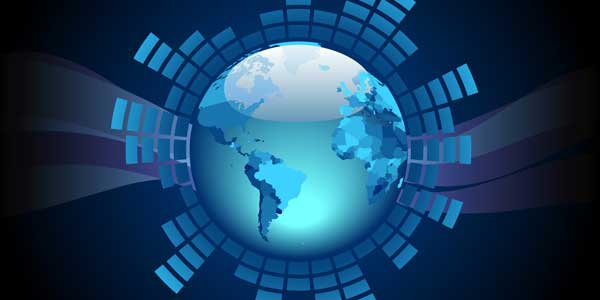
© Unknown
Our planet is a place rich in sound. This panoply of sound is so important to our perception of our world that when the Voyager spacecraft were launched as our ambassadors to the universe, a collection of sounds from Earth were part of what they took with them. Along with images and other information about Earth and humankind, there were recordings (on very old-fashioned analog disks) of the sounds of natural phenomena such as wind, surf, and thunder. There were also animal sounds, music from many cultures, and spoken greetings in several dozen languages, including a clip from then-President Jimmy Carter.
The sounds on that disk are the sounds most of us know -- the sound of storms, oceans, animals, people speaking, singing, and playing music. But nowhere on that disk are the kinds of sounds an alien race might first hear when approaching Earth -- the sounds of the Earth itself. Some are simple pops and crackles, but some are
so rich or so
eerie they seem to defy their natural origin.
The sounds of EarthIt's a staple of many science fiction stories that if and when aliens approach or "tune in" to Earth what they first hear may well be old radio broadcasts from the early 20th century or TV sitcoms from the 1950s. (Such writers don't seem to consider the much more powerful man-made signals from Earth such as deep-space radar and data pulses from radio telescopes, missile-warning radars, and multi-megawatt ultra-low-frequency signals sent to deep-running submarines.)
But overwhelming all man-made signals would be the signals emitted by Earth itself, particularly those emanating from the Earth's maelstrom of high-powered electrical activity, our atmosphere.
Zap, crackle, and popWe think of the Earth's atmosphere as gases, wind, and sometimes water and rain. But Earth's atmosphere also continuously sizzles with high-voltage electricity. At any given moment there are hundreds of thunderstorms active around the world, in total generating an average (estimates vary) of 30 to 100 lightning bolts per second, every second of every day.
Most of those lightning bolts travel from cloud to cloud, a lesser proportion are cloud to ground. But every one of of those lightning bolts releases millions of volts, creating a a finger-thin but miles-long plasma field that propagates at speeds over 2,000 miles (3,200 km) per second and reaches temperatures far hotter than the Sun. The enormously violent shock to the air immediately surrounding the lightning bolt is what causes the thunderclap that follows, but the sudden discharge of such enormous electrical power causes a far greater electromagnetic "thunderclap" that will propagate several times around the Earth before it dies out. And this blast of enormous electromagnetic energy happens with every lightning bolt, dozens every second, millions every day.
Earth's music on your radioRadio receivers operate by detecting electromagnetic signals, and on an AM or shortwave radio receiver lightning bolts can be readily heard as crackles, pops, or even loud bangs that resemble gunshots, depending on distance and intensity. Other electrical storm phenomena such as
sprites, blue jets, and elves (yes, "elves") -- all of them forms of
Transient Luminous Effects, or TLEs -- emit their own electromagnetic signals that add to the symphony.
And a lightning bolt is never alone. Every storm generates barrages of them. Other storms -- there are always other storms -- farther away, even around the world, contribute their own barrages of pops, zaps, crackles, and eerie whistles; all of them blending into the "static" you hear when you tune slowly across the dial of an AM or shortwave radio. (A VLF receiver will pick up even more -- see below.) Some of the hiss you hear across the radio dial is cosmic noise from the rest of the universe, but the lively bits are the music of Earth -- the sound of the very electrically active atmosphere of a planet that never sleeps.
Sferics, tweeks, whistlers - the VLF music of INSPIRESome of the most avid listeners of the sounds of Earth are the volunteer members of NASA's program INSPIRE ( "Interactive NASA Space Physics Ionosphere Radio Experiments"). The members of
INSPIRE build their own very low frequency (VLF) receivers from simple $10 kits; these very basic VLF receivers allow them to monitor directly the electrical sounds of the Earth's atmosphere, using their recordings and observations to further research on VLF radio phenomena. Data from the INSPIRE program's volunteers and $10 receivers have made great contributions to space physics and ionospheric research for more than 20 years.
To sample what the INSPIRE members hear, see the program's
samples page on types of VLF signals. It's the true music of our planet.
Reader Comments
to our Newsletter